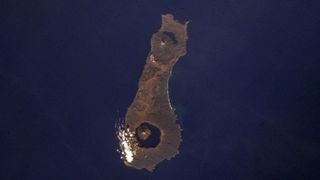QUICK FACTS
Where is it? Onekotan Island, northwest Pacific Ocean [49.35544352, 154.7164388]
What’s in the photo? Clouds reflecting off the mirror-like surface of a crater lake between two halves of a volcano
Who took the photo? An unnamed astronaut on the International Space Station (ISS)
When was it taken? Aug. 19, 2023
This striking astronaut photo shows one of Russia’s deepest lakes sandwiched between two halves of a volcano as its surface was transformed into a reflective sea of swirling clouds thanks to a rare mirror-like phenomenon, known as “sunglint.”
The volcanic “nesting dolls,” collectively known as the Krenitsyna Volcano, are located on the southern tip of Onekotan Island in the Kuril Islands — a Russian archipelago located in the Pacific Ocean between the Kamchatka Peninsula and Hokkaido, the second-largest and northernmost island in Japan.
The volcano has two main parts: The large lake-filled, crater-like depression, known as the Tsar-Rusyr caldera, which spans up to 5 miles (8 kilometers) across; and the cone-shape mountain that rises out of the water, known as the Krenitsyna Peak, which reaches approximately 4,200 feet (1,300 meters) above sea level. This unusual configuration is the result of the volcano collapsing in on itself, before a new peak grew up out of the active remnant.
The crater lake that sits within the Tsar-Rusyr caldera and surrounds Krenitsyna Peak is known as Kol’tsevoye Lake. It is 1,200 feet (370 m) deep, making it one of the deepest lakes in Russia, according to NASA’s Earth Observatory.
Related: See all the best images of Earth from space
Sunglint effect
In the astronaut photo, Kol’tsevoye Lake looks as if it has been covered by low-lying clouds sitting at the bottom of the caldera. However, there are no clouds in this image. Instead, what you can see is clouds passing high over the island that have been reflected off the water’s surface.
Normally, a standard reflection would not be strong enough to make the clouds look so real. But in this case, the orientation of the sun relative to the ISS means that the sun’s full beam is being reflected straight back at the astronaut taking the photo, creating an effect known as sunglint, which transforms a large body of water into a giant silver mirror. The caldera’s rim stands roughly 1,000 feet (300 m) above the lake’s surface, creating shadows that help to accentuate the cloudy illusion.

However, the clouds are still only visible because the astronaut is positioned above the volcano at an angle that allows them to see the sunglint without being right on top of the island, which would mean the clouds would block their view of the lake.
The Krenitsyna Volcano is still active and last erupted in 1952 with a “moderate” outburst that lasted for around a week, according to the Smithsonian Institute’s Global Volcanism Program. But its last major eruption was likely around 7,600 years ago.
Interestingly, another set of volcanic nesting dolls with its own crater lake, collectively known as the Nemo Volcano, is positioned on the northern end of Onekotan Island. However, in this case, the lake does not surround the peak that has grown out of this collapsed caldera.
